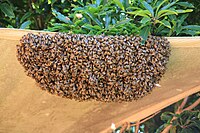
Photo from wikipedia
Background Artificial rearing of honey bee larvae is an established method which enables to fully standardize the rearing environment and to manipulate the supplied diet to the brood. However, there… Click to show full abstract
Background Artificial rearing of honey bee larvae is an established method which enables to fully standardize the rearing environment and to manipulate the supplied diet to the brood. However, there are no studies which compare learning performance or neuroanatomic differences of artificially-reared (in-lab) bees in comparison with their in-hive reared counterparts. Methods Here we tested how different quantities of food during larval development affect body size, brain morphology and learning ability of adult honey bees. We used in-lab rearing to be able to manipulate the total quantity of food consumed during larval development. After hatching, a subset of the bees was taken for which we made 3D reconstructions of the brains using confocal laser-scanning microscopy. Learning ability and memory formation of the remaining bees was tested in a differential olfactory conditioning experiment. Finally, we evaluated how bees reared with different quantities of artificial diet compared to in-hive reared bees. Results Thorax and head size of in-lab reared honey bees, when fed the standard diet of 160 µl or less, were slightly smaller than hive bees. The brain structure analyses showed that artificially reared bees had smaller mushroom body (MB) lateral calyces than their in-hive counterparts, independently of the quantity of food they received. However, they showed the same total brain size and the same associative learning ability as in-hive reared bees. In terms of mid-term memory, but not early long-term memory, they performed even better than the in-hive control. Discussion We have demonstrated that bees that are reared artificially (according to the Aupinel protocol) and kept in lab-conditions perform the same or even better than their in-hive sisters in an olfactory conditioning experiment even though their lateral calyces were consistently smaller at emergence. The applied combination of experimental manipulation during the larval phase plus subsequent behavioral and neuro-anatomic analyses is a powerful tool for basic and applied honey bee research.
Journal Title: PeerJ
Year Published: 2017
Link to full text (if available)
Share on Social Media: Sign Up to like & get
recommendations!